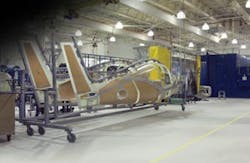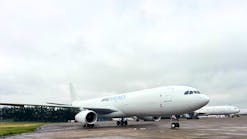Nothing creates fear in the hearts of mechanics, manufactures, owners, and operators alike than the words “aircraft corrosion.” For the mechanic, aircraft corrosion means careful and lengthy inspections in damp, dark, and hard-to-get-to places, usually followed by detailed and often major repairs. To the owner and operator corrosion is just plain bad news, and will mean their aircraft will be out of service for expensive repairs. In some cases it will also mean an unfortunate and considerable loss of asset value. For regulatory agencies, corrosion can be considered a life-threatening event that must be aggressively addressed and prevented.
How can we, those who make our livelihood maintaining aircraft, prevent, control, detect, and repair corrosion? This has been our challenge since we began using metal on our airplanes. I would be willing to place a bet that the Wright Flyer, and the aluminum engine block in particular, picked up some corrosion while going through its paces at Kitty Hawk. Charles Edward Taylor probably made some preventative modifications on the next models to prevent corrosion from further hindering the progress being made in aircraft development.
We all know that metals exposed to damp environments over time, particularly salty marine environments, will inevitably experience damage. For those of us who have been out of the chemistry class for a couple of years, corrosion is the electrochemical deterioration of metal that is a result of its chemical interaction with the surrounding environment. Natural science ruled our industry as much in 1903 at Kill Devil Hill, as it does in our 2009 operating environments. When there is a corrodible metal or alloy, the presence of a dissimilar conductive material (cathode), electrolytes, and an electrical path between the anode and the cathode, we will have corrosion on our airplanes.
As aircraft maintainers we understand that corrosion prevention is an ongoing task that is never completed. We understand better than anyone else that maintaining an aggressive control program that includes inspection, prevention treatments, and repairs is vital to ensuring the airworthiness of our aircraft.
Watch out for corrosion!
Corrosion is insidious and can develop anywhere at any time. From experience on the flight line, overhaul docks, and various back shops, I suggest that there are several key areas that must be visually inspected, as well as have nondestructive tests routinely performed. I would like to share my own priority list of places that aircraft corrosion will most likely occur. They are in the following order of probability.
- Floor boards and structure around and under lavatories and galleys — should be clear why this is top of the list
- Seat tracks and any place on the flight deck or main cabin that passengers and crew can spill drinks or drop food
- All battery compartments
- All sumps and drains, specifically in integral type fuel tanks; metal-eating microbes grow in water trapped in fuel tanks — I have made mortgage payments, paid for vacations and school tuition with overtime wages I earned from major structural repairs caused by corrosion in fuel tanks, lavs, and galleys
- Structures below baggage compartment floors, particularly the lower stingers and clips, bottom skin lap joints, and areas under antennas, pitots, and drain mast
- All wheel wells and flap gaps — landing gear and wheel assemblies and flap drives, flap tracks, and exposed rods and cables are very susceptible to corrosion, especially if the aircraft is flying in marine environments or airports with winter deicing operations
- Electrical compartments, including cannon plugs and attachment points
- Avionic component connector pin and circuit board edge connectors
- Hydraulic compartment structure
- Aircraft cables
- Engine exhaust and oil sump and drain areas
Types of corrosion
I have seen corrosion in all its many forms and in my experience, galvanic and intergranular corrosion are the most insidious and dangerous types of aircraft corrosion. Galvanic corrosion occurs when two dissimilar metals make contact with one another in the presence of an electrolyte. Galvanic is most troublesome because it can affect electrical and avionics systems’ pin and edge connectors. This type of corrosion can lead to random faults and life-threatening conditions, like uncommanding component and aircraft operations. Intergranular corrosion is hard to detect in the early stages, and if left undetected can lead to catastrophic structural failure. When improperly heat treated T2014 and T7075 aluminum appears to be most susceptible to this type of corrosion.
Most all of us have had Corrosion Physics 101, and have good corrosion control programs in place. The regulatory agencies and original equipment manufacturers (OEMs) have very detailed directions in their documentation on how to prevent, detect, and repair corrosion. I don’t want to dwell on these maintenance practices; rather I wanted to take a look further upstream in the manufacturing chain to see what the OEMs and parts manufacturers are doing to inhibit corrosion. I was curious to know if the OEMs and component manufacturers are using any new materials, manufacturing processes, or new design features to eliminate or prohibit corrosion. I thought if we could get a look at the current processes and materials being used to build today’s airframes, then we probably could estimate the scale of corrosion problems in the near term, as well as a few years down the road.
New materials and machining processes
I had an opportunity to visit with Mark Heasley, president and chief executive officer of Synchronous Aerospace Group out of Santa Ana, CA, about this very topic. Synchronous is a provider of flight-critical machined aluminum and hard-metal components, integrated kits and complex assemblies to the commercial, military, and space markets.
During our conversation Heasley said its companies are very progressive and customer focused. Synchronous is always looking for ways to prevent corrosion downstream in final assembly. Traditionally, the OEM provides Synchronous with standards and specifications for the components it manufactures.
However, Synchronous has taken some steps to prevent corrosion during and after its machining processes. It has virtually eliminated parts and components corrosion by going to a water-based synthetic cooling solution in its machining processes. The synthetic solution helped to reduce heat and subsequent stress to parts and components. After machining, the parts are coated with LPS oil and wrapped in a customer-specified craft paper, further reducing opportunities for corrosion.
I asked Heasley specifically about composites, as Synchronous recently announced that it has acquired Helicomb International Inc., a provider of aerospace composite structures based in Tulsa, OK. Helicomb produces commercial and military aircraft structures manufactured from a broad range of composite and metal-bonded materials for leading aerospace manufacturers, Tier 1 suppliers, and overhaul service providers.
I was curious about the types of graphite composite materials that are being used because they present corrosion opportunities when they come into contact with the traditional alloys used in aircraft manufacturing. There is a misconception that composite materials are not affected by corrosion like aluminums and steels. Composites are not inert; they are excellent cathodes and can generate galvanic corrosion. When the aircraft is operating in marine or other moist environments, composite components can become very reactive. The traditional method for preventing this type of corrosion is to apply a faying surface of sealant or quality primer between metal and composite joints to prevent moisture buildup, thereby reducing galvanic potential.
Heasley said that the company is seeing some changes in airframe materials on the B787, Airbus 350, and the F35 Joint Strike Fighter. These changes include using titanium rather than aluminum in areas that are mated to composite components, thus reducing the potential for galvanic corrosion.
In today’s operating environment, all of us — manufacturers, mechanics, and owners and operators — must aggressively prevent and control corrosion on our expensive aircraft. The down side in today’s economy is that aircraft owners will be reducing their operating hours, resulting in aircraft being parked in all kinds of corrosion-inducing environments. Many aircraft will not be in cozy hangars or dry environments like Tucson or Mojave. The upside is that the maintenance departments will have increased opportunities to conduct detailed visual and nondestructive testing. Then they will have that precious downtime to treat, replace, and repair any corrosion-damaged parts, thus ensuring that the aircraft are safe and ready to fly when the economy cycles up again.
Charles D. Chandler is Field Editor for AMT. A Texas-based A&P, he received his training at Spartan College of Aeronautics.





